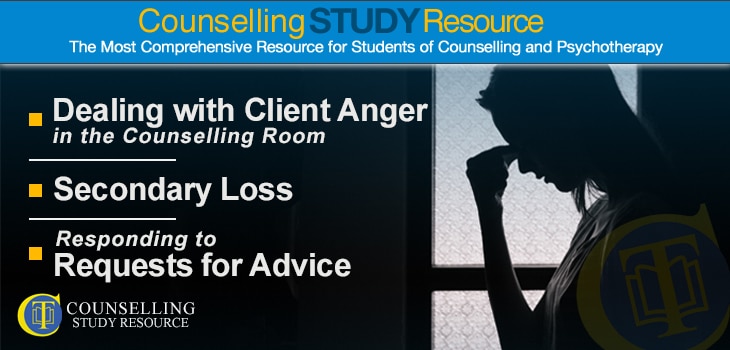042 – Dealing with Client Anger in the Counselling Room – Secondary Loss – Responding to Requests for Advice
In episode 42 of the Counselling Tutor Podcast, Rory Lees-Oakes and Ken Kelly discuss how to deal with clients who display anger in the therapy room. ‘Theory with Rory’ examines secondary loss. Finally, the presenters talk about what to do if a client asks you for advice.
Dealing with Client Anger in the Counselling Room (starts at 3.11 mins)
Ken and Rory discuss how we as counsellors might feel and deal with clients who present with anger. Although anger is often portrayed as a negative emotion, it can – used in the right way – be a very positive one in bringing about beneficial change.
For example, Nelson Mandela, Maya Angelou and the suffragettes were all angry about issues of injustice, and channelled this emotion into changing the world for the better. Three key tips are offered:
- If you feel uncomfortable with anger, spend some time thinking through why this is – your own experience of anger and angry people (think transference and countertransference. Personal development and having your own counselling are really important here.
- If a client presents with anger issues, contract with them about this, asking how they expect it to manifest itself in the counselling room, and explaining what would be acceptable (expressing strong anger) and what would not (abusing the counsellor and/or their belongings).
- Think about Petruska Clarkson’s five-relationship model: the reparenting relationship is based on the counsellor providing stability and acting as an adult with clients, especially those who may have experienced poor parenting as youngsters. This can be an effective way of defusing anger.
Secondary Loss (starts at 17.26 mins)
If you want to work as a grief counsellor, it is best to get some specific training in this field. One concept often encountered in bereavement work is secondary loss. This refers to losses additional to the actual death itself. Secondary loss can skew the bereaved person’s view of the person who died.
Rory recounts the story of a woman whose husband (who was also her business partner) died suddenly. It transpired that he had left a lot of debt of which his wife had been unaware. Apart from losing her husband, she also lost her livelihood, her financial security, her identity as a business-woman, her planned future, and her relationships with some friends (who deserted her). Another common secondary loss is loss of faith, with clients wondering how their religious beliefs fit with what has happened to them.
In understanding secondary loss, you may like to consider Maslow’s hierarchy of needs: if the under-layers of this (e.g. the money to buy food, and a place to live) are suddenly pulled from under you by the death of a loved one, there are multiple losses to deal with.
When counselling a grieving client, it may be necessary to work first with the impact of secondary loss before they are ready to work through the emotions related to their loved one dying. It can be helpful to signpost them to other agencies who may be able to provide the practical support they need (e.g., food banks and Citizens Advice).
For more information, see Rory’s free download on secondary loss.
Free Handout Download
What is Secondary Loss?
Responding to Requests for Advice and Guidance (starts at 26.08 mins)
In counselling, it is common to be asked by clients: ‘What would you do in my situation?’ In general, it’s really important to ensure we don’t erode the autonomy of the client: they themselves already know best the right way forward for them, even if they are not yet aware of this. So a good answer here might be: ‘Anything I want’ – showing the client that it is their life to do with as they wish (a very freeing answer). Another possible response is: ‘If you had a friend going through the same thing, what would you advise them to do?’ (their response in effect being their own advice to themselves).
But what if a client asks a question that we (through our training) know the answer to? Rory advises keeping the answer generic rather than personalising it to that client. For example, if they ask about whether a difficulty they are experiencing may relate to the parenting they received as a child, you could describe in general terms the effect that a particular style of parenting has been found to have on people. Rory believes that this can help in terms both of providing information (so empowering the client) and normalising the client’s experience (reassuring them that what they are experiencing is natural in the circumstances).
And what if a client asks, say, whether you think the amount of alcohol they are drinking is harmful to them? It is OK to reply honestly if this is based on factual health information (i.e. not on any prejudice of your own) and is intended to help keep the client safe.
